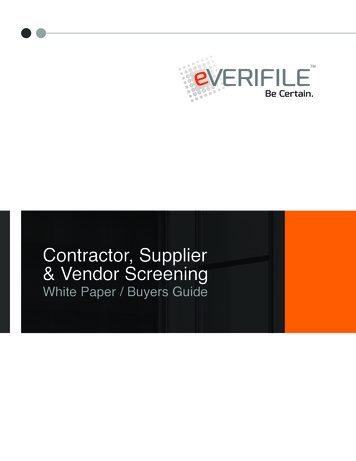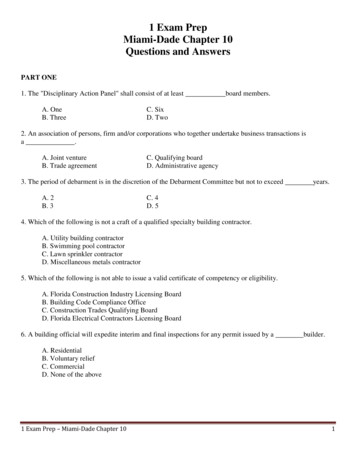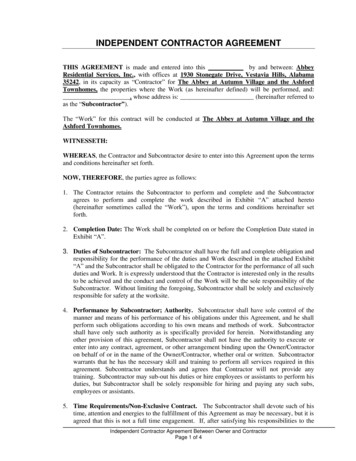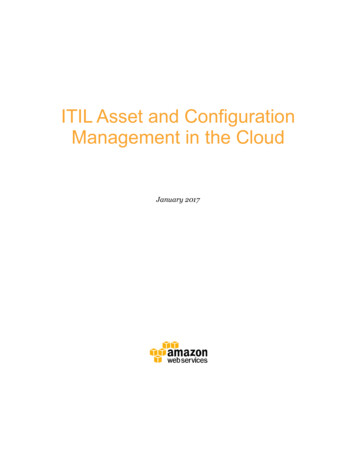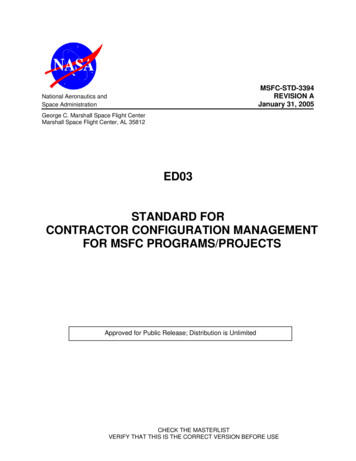
Transcription
MSFC-STD-3394REVISION AJanuary 31, 2005National Aeronautics andSpace AdministrationGeorge C. Marshall Space Flight CenterMarshall Space Flight Center, AL 35812ED03STANDARD FORCONTRACTOR CONFIGURATION MANAGEMENTFOR MSFC PROGRAMS/PROJECTSApproved for Public Release; Distribution is UnlimitedCHECK THE MASTERLISTVERIFY THAT THIS IS THE CORRECT VERSION BEFORE USE
Multiprogram/Project Common-Use DocumentED03Title: Standard for Contractor CMRequirements, MSFCPrograms/ProjectsDocument No.: MSFC-STD-3394Revision: AEffective Date: January 31, 2005Page 2 of 70DOCUMENT HISTORY 005DescriptionInitial ReleaseGeneral: updated language utilizing “shall” for requirements(avoiding use of must or will) per Rules Review; 2.0 Changesreflecting new Marshall Program Requirements; 6.1 changeacknowledging variance in selection CIs for technology studies;6.4 change providing greater detail on engineering drawingrequirements and content; 6.4.2 Added section for CAD models;7.1 Add text specifying location of engineering release system; 8.7New paragraph defining post-deployment software/firmwarechange process; 8.7 Added information relative to MSFC form460 in the deviation/waiver process; 9.3.5 Add paragraphdescribing software status accounting; 10.2 Added requirementfor specific planning issued to be addressed during planning; 10.3Made allowances for Government overview of FCA/PCA, addedrequirement for Contractor to actually “do” the as-built/asdesigned review, and added contractor duties regardingsoftware/firmware, made miscellaneous changes to clarifycontractor support; 10.4 Added contractor administrative andtechnical responsibilities; 11.2 New paragraph describing CMutilization of results of Independent Verification and Validation(IV&V); 11.3 Describes delivery of the software product; 11.4Adds marking and labeling instructions for software/firmware;Appendix A added specific coverage for software/firmware;Appendix B added for software configuration management plan;Appendix C added sample copy of MSFC form 460; Appendix Dadded new write-up for Acceptance Data Package expandsdelivery of ADP to require updated delivery whenhardware/software is shipped to a new location and to ; includesseparate requirements for hardware different fromsoftware/firmware. Added guidance Appendices H - Guidance forProcessing Urgent-Emergency Software Changes and Appendix I– Documentation Guidance for FCA/PCA.CHECK THE MASTERLISTVERIFY THAT THIS IS THE CORRECT VERSION BEFORE USE
Multiprogram/Project Common-Use DocumentED03Title: Standard for Contractor CMRequirements, MSFCPrograms/ProjectsDocument No.: MSFC-STD-3394Revision: AEffective Date: January 31, 2005Page 3 of 70TABLE OF CONTENTSPARAGRAPHPAGEFOREWORD .51.1.11.2SCOPE/PURPOSE .6Scope/Purpose.6Applicability .62.2.12.2APPLICABLE AND REFERENCE DOCUMENTS .6Applicable Documents .6Reference Documents .73.ACRONYMS/DEFINITIONS .74.GENERAL REQUIREMENTS.75.5.15.2CONFIGURATION MANAGEMENT PLANNING .8General .8Contractor’s CM Plans .86.6.16.26.36.46.56.6IDENTIFICATION .8Configuration Identification.8Specifications .10Interface Identification .11Drawing and Models .13Identification Numbering .15Lot and Serial Numbering .177.7.17.27.37.47.57.6ENGINEERING RELEASE INFORMATION.18Engineering Release.18Elements of Data Required for Hardware Items.19Elements of Data Required for Software Items .20Production Release Functional Capabilities.20Release of Engineering Changes .21Field Release Functional Capabilities .218.8.18.28.38.48.58.68.78.88.9CONFIGURATION CONTROL .21General .21Configuration Control Boards.21Changes, Deviations, and Waivers .21Engineering Change Proposal .23Record Engineering Change Proposal.23Field Engineering Change (FEC) .23Software/Firmware Field Engineering Change .23Deviation and Waiver Request.24Modification Kit and Instructions .24CHECK THE MASTERLISTVERIFY THAT THIS IS THE CORRECT VERSION BEFORE USE
Multiprogram/Project Common-Use DocumentED03Title: Standard for Contractor CMRequirements, MSFCPrograms/ProjectsDocument No.: MSFC-STD-3394Revision: AEffective Date: January 31, 2005Page 4 of 70TABLE OF CONTENTS (Continued)PARAGRAPHPAGE9.9.19.29.3CONFIGURATION ACCOUNTING.26General .26Configuration Accounting Requirements.26Configuration Accounting TION VERIFICATION AND AUDIT.28General .28Planning .28Contractor Support.28Objectives .29Contractor Responsibilities .30In-process Configuration Management Audits .31“Other” Reviews .3111.11.111.211.311.4SOFTWARE CONFIGURATION MANAGEMENT .32Preparation.32Independent Verification and Validation (IV&V) .32Delivery .32Software/Firmware marking and Labeling.32LIST OF TABLESTableIPageClass I Change uration Management Plan.34Software Configuration Plan .39Specification Change Notice and Instructions.42Interface Control.43Change Control .45Acceptance Data Package.58Definitions, Abbreviations and Acronyms.62Guidance for Processing Urgent-Emergency Software Changes .68Documentation Guidance for FCA/PCA .70CHECK THE MASTERLISTVERIFY THAT THIS IS THE CORRECT VERSION BEFORE USE
Multiprogram/Project Common-Use DocumentED03Title: Standard for Contractor CMRequirements, MSFCPrograms/ProjectsDocument No.: MSFC-STD-3394Revision: AEffective Date: January 31, 2005Page 5 of 70FOREWORDThis standard defines configuration management principles for design, development,integration, operation, and logistical support of Configuration Items and Computer SoftwareConfiguration Items managed by MSFC throughout the acquisition life cycle. It incorporatesthe industry-Government consensus standard ANSI-EIA 649 principles.The focus of this standard is on performance requirements rather than the details of thedesign solution. MSFC management of the CM process is based on insight of contractorpractice and application of ANSI-EIA 649 principles. These principles are relevant toconfiguration management practices through the entire life cycle, including "technology"programs where technology is the precursor to product development.This standard applies only to the extent specified in contracts.An important function of this standard is to facilitate the use of automation tools by providingstandard criteria of the CM process. The predominant media for exchange of informationhas transitioned from a paper base to a digital one. Information technology concepts andstandards for data access, data transfer, and data sharing have increased the opportunityfor Government and industry to productively integrate information from distributed sources.This leads to a true virtual enterprise that includes all the Configuration Managementinformation necessary for the life cycle support and maintenance of equipment andsoftware.Forms cited herein are available at Usage of these forms is not mandatory; contractor-equivalent forms may be used as long as thecontent of information requested is furnished.CHECK THE MASTERLISTVERIFY THAT THIS IS THE CORRECT VERSION BEFORE USE
Multiprogram/Project Common-Use DocumentED03Title: Standard for Contractor CMRequirements, MSFCPrograms/ProjectsDocument No.: MSFC-STD-3394Revision: AEffective Date: January 31, 2005Page 6 of 70STANDARD CONTRACTOR CONFIGURATION MANAGEMENTREQUIREMENTS, MSFC PROGRAMS/PROJECTS1.SCOPE/PURPOSEScope/Purpose. The purpose of this document is to establish requirements for1.1implementing Configuration Management (CM) on MSFC contracts to design, develop,fabricate, integrate, operate, or provide logistical support to hardware, software, and firmwareitems. This document also establishes requirements for MSFC contracts providing technologyor requirements that are precursors of program design.1.2Applicability. This document is applicable to all MSFC contractors performing design,development, fabrication, integration, operations, or logistical products and services for MSFCprograms or projects. These standards apply to flight, flight demos, protoflight, and groundsupport equipment and may be tailored by the individual programs/projects.2.APPLICABLE AND REFERENCE DOCUMENTS2.1Applicable Documents. The following documents of the issue in effect on the date ofincorporation of these requirements form a part of this document to the extent specified herein.2.1.12.1.2Federal Documents.CatalogingHandbook H4/H8Commercial and Government Entity (CAGE) CodesMIL-STD-130Identification Marking of U.S. Military PropertyMIL-STD-961Defense SpecificationsMIL-STD-962Defense Standards and HandbooksMPR 8040.1Configuration Management, MSFC Program/Projects (AppendixZ, CM Audits)NPD 2190.1NASA Export Control ProgramNPR 2200.2Requirements for Documentation, Approval, and Disseminationof NASA Scientific and Technical InformationNPR 7150.2NASA Software Engineering RequirementsIndustrial Standards.ASME Y14.5Dimensioning and TolerancingASME Y14.24Types and Applications of Engineering DrawingsASME Y14.35Revision of Engineering Drawings and Associated DocumentsCHECK THE MASTERLISTVERIFY THAT THIS IS THE CORRECT VERSION BEFORE USE
Multiprogram/Project Common-Use DocumentED03Title: Standard for Contractor CMRequirements, MSFCPrograms/Projects2.23.Document No.: MSFC-STD-3394Revision: AEffective Date: January 31, 2005Page 7 of 70ASME Y14.41Digital Product Definition Data PracticesASME Y14.100Engineering Drawing PracticesIEEE/EIA 12207Software Life Cycle ProcessIEEE 1042Guide to Software Configuration ManagementReference Documents.ANSI/EIA 649National Consensus Standard for Configuration ManagementOMB Circular A-130Management of Federal Information ResourcesDD Form 250Material Inspection and Receiving ReportDD Form 1149Requisition and Invoice/Shipping DocumentMSFC Form 460Discrepancy RecordMSFC Form 847Deviation/Waiver Approval Request (DAR)MSFC Form 2348Engineering Change ProposalMSFC Form 2490Installation Notice Card (INC)MSFC Form 4229Preliminary/Interface Revision Notice (PIRN/IRN)MSFC Form 4242Record Engineering Change ProposalACRONYMS/DEFINITIONSFor a definition of terms and a list of abbreviations and acronyms used in this document, seeAppendix G.4.GENERAL REQUIREMENTSThe contractor shall establish a CM program covering the appropriate life-cycle phases of theapplicable Configuration Items (CIs) and Computer Software Configuration Items (CSCIs). Inthis document, CI is a broad term that includes CSCI whenever appropriate. The requirementsof this document shall be implemented and tailored as stated in the contract Statement of Work(SOW) and consist of the following elements:a.Configuration Identificationb.Configuration Controlc.Configuration Status AccountingCHECK THE MASTERLISTVERIFY THAT THIS IS THE CORRECT VERSION BEFORE USE
Multiprogram/Project Common-Use DocumentED03Title: Standard for Contractor CMRequirements, MSFCPrograms/Projectsd.Document No.: MSFC-STD-3394Revision: AEffective Date: January 31, 2005Page 8 of 70Configuration Verification; Configuration Verification/Validation for Software/FirmwareThe contractor shall assure that all appropriate subcontractors comply with the requirements ofthis CM program.5.CONFIGURATION MANAGEMENT PLANNING5.1General. The contractor shall plan a CM program in accordance with the requirementsdefined in this standard. The CM program shall be tailored appropriately for the particular CIs,their scope and complexity, and the contracted phase(s) of the life cycle.5.2Contractor's CM Plans. The contractor shall develop a CM plan or plans that describethe processes, methods, forms, and procedures to be used for management of the functionaland physical characteristics of the CIs. The CM plan, when approved, forms the basis forimplementation of CM requirements and shall be maintained by the contractor. The content andformat of the CM plan shall be in accordance with Appendix A as tailored by the contract. Thesoftware CM plan shall be prepared in accordance with contract direction. The contractor shallsubmit the CM plan and changes thereto in accordance with the contract Data ProcurementDocument (DPD).6.IDENTIFICATION6.1Configuration Identification. Configuration Identification is the basis from which theconfiguration of products is defined and verified; products and documents are labeled; changesare managed; and accountability is maintained. The contractor shall implement configurationidentification for every CI.Note: Technology driven programs defy clear definitions of what constitutes a configurationitem. Typically government funded studies on technology issues do not result in a designedproduct requiring configuration management. Prototypes that are scaled down visual models orcomputer programs that are simply Computer-Off-The-Shelf (COTS) unmodified software oreven applications of common desktop programs may be better handled without formal control ofdesign. On the other hand, formal requirements, controlled design over a life cycle, and a formalchanges clause in the contract indicate that hardware or software requires formal configurationmanagement to control. The configuration management plan shall identify these items, if notinitially, then in a future revision.Note: The term “configuration item” should not be applied to software products that areemployed in the development process of a Program/Project, and considered Computer-Off-TheShelf (COTS) software. Configuration item would apply to those software products that are theresult of specific design requirements generated for the Program/Project, and therefore wouldbe subject to formal configuration management control for the duration of the Program/Projectlifecycle. These configuration items shall be identified in the Configuration Management (CM)Plan.6.1.1 Configuration Identification Baselines. The contractor shall accomplish configurationidentification through formal documentation that defines the baseline being established andprovides for the control and accounting of future changes to that baseline. The design of eachCHECK THE MASTERLISTVERIFY THAT THIS IS THE CORRECT VERSION BEFORE USE
Multiprogram/Project Common-Use DocumentED03Title: Standard for Contractor CMRequirements, MSFCPrograms/ProjectsDocument No.: MSFC-STD-3394Revision: AEffective Date: January 31, 2005Page 9 of 70CI progresses through baseline evolution from basic requirements into a final verified and builtproduct. The baselines are defined as the Functional Baseline, Allocated Baseline,Development Baseline, and Product Baseline. A baseline identifies an agreed-to description ofattributes of a CI at a point in time and provides a known configuration to which changes areaddressed. Baselines are established by agreeing to (and documenting) the stated definition ofa CIs attributes. The approved "current" baseline defines the basis of the subsequent change.a. Functional Baseline. The Functional Baseline is the approved configuration documentationthat describes a system's or top-level CIs performance requirements (functional, interoperability,and interface characteristics) and the verification required to demonstrate the achievement ofthose specified characteristics. The Functional Baseline is controlled by the Government.b. Allocated Baseline – The Allocated Baseline is the approved performance-orientedconfiguration documentation for a CI to be developed that describes the functional and interfacecharacteristics that are allocated from a higher level requirements document or a CI and theverification required to demonstrate achievement of those specified characteristics. Theallocated baseline extends the top-level performance requirements of the functional baseline tosufficient detail for initiating manufacturing or coding of a CI. The Allocated Baseline iscontrolled by the Government.c. Development Baseline. The Development Baseline is the contractor's design andassociated technical documentation that defines the contractor’s evolving design solution duringdevelopment of a CI. The developmental configuration for a CI consists of contractor internallyreleased technical documentation for hardware and software design that is under thedeveloping contractor's configuration control.d. Product Baseline - The Product Baseline is the approved technical documentation thatdescribes the configuration of a CI during the production, fielding/deployment and operationalsupport phases of its life cycle. It is not established until successful certification following aFunctional Configuration Audit and a Physical Configuration Audit. The product baselinedescribes:— Detailed physical or form, fit, and function characteristics of a CI— The selected functional characteristics designated for production acceptance testing— The production acceptance test requirements.Once the Product Baseline is established, the Government determines how it shall becontrolled.6.1.2 Functional and Allocated Baseline Relationships. Interface control documents areconsidered part of the functional and/or allocated baselines to the extent that they arereferenced in and supplement the performance specifications that constitute the applicablebaselines. Contractor implementation of the Functional and Allocated Baseline Requirementsinvolves the creation and release of engineering documentation that incrementally defines theconfiguration of the specific product. The function and allocated baseline represents thecontractor’s detailed design solution and is controlled by the Government. It may or may notinclude a detail specification for the product. The contractor is responsible for the configurationCHECK THE MASTERLISTVERIFY THAT THIS IS THE CORRECT VERSION BEFORE USE
Multiprogram/Project Common-Use DocumentED03Title: Standard for Contractor CMRequirements, MSFCPrograms/ProjectsDocument No.: MSFC-STD-3394Revision: AEffective Date: January 31, 2005Page 10 of 70control of the developmental configuration and may iteratively design, release, prototype, andtest until the functional and allocated requirements are satisfied. The developmentalconfiguration ultimately includes the complete set of released and approved engineering designdocuments, such as the engineering drawings and associated lists for hardware, software, andinterface and database design documents for software. By reference within this documentation,it also includes test and verification documents.6.1.3 Product Baseline Requirements. The product baseline is the approved documentationthat completely describes the functional and physical characteristics of the CI, and any requiredjoint and combined operation’s interoperability characteristics of a CI (including acomprehensive summary of the other environment(s) and allied interfacing CIs or systems andequipment). It consists of the Product Configuration Identification which defines theconfiguration of a CI during production, operation, maintenance and logistic support phases ofits life cycle and which prescribes the requirements for 1) fit and function characteristics of a CI,2) the functional characteristics selected for production acceptance testing, and 3) theproduction acceptance tests.The Product Configuration Identification includes the complete set of released and approvedengineering design documents such as engineering models, engineering drawings andassociated lists for hardware, software, interfaces, operations documentation, and databasedesign documents for software. (These are the configurations of the documents that wereconsidered the developmental configuration.) The product baseline may include the 2-Ddrawings or a 3-D engineering model of a hardware product, and for software a representationof the CSCI source code. It also includes by reference the material and process specificationsinvoked by the engineering documentation.6.2Specifications. Each CI shall be documented in a performance specification as definedin MIL-STD-961. At the system or program level, Systems Specifications or a SystemRequirements document may be required to establish comprehensive and definitive set ofsystem performance requirements. These shall follow the same content requirements as existfor CI specifications. (Exceptions shall be documented in the Configuration Management Plan.)Note: MIL-STD-961 describes different types of specifications, including performancespecifications, detail specifications, and program-unique specifications. A program-uniquespecification is prepared when there is little likelihood that the requirements will extend beyonda single program. A program-unique specification can be prepared as a performancespecification or a detailed specification. A performance specification defines requirements interms of results required and criteria for verifying compliance. A detailed specification goesbeyond describing functions and defines in detail the methodology to build the product.Specifications are also categorized as to type-like system specification, Configuration Item (CI)specification, material specification, software specification, or process specification.6.2.1 Specification Requirements. The contractor shall prepare a performance specificationas a program-unique document for each identified CI in accordance with MIL-STD-961. Forsoftware specifications and requirements, the contractor shall prepare documentation inaccordance with IEEE 12207 and IEEE 1042.CHECK THE MASTERLISTVERIFY THAT THIS IS THE CORRECT VERSION BEFORE USE
Multiprogram/Project Common-Use DocumentED03Title: Standard for Contractor CMRequirements, MSFCPrograms/ProjectsDocument No.: MSFC-STD-3394Revision: AEffective Date: January 31, 2005Page 11 of 706.2.2 Requirements When Submitting Specification Changes. The contractor shall providedetailed change information when proposing changes to baselined specifications and shallmaintain traceability of changes to other baselines for each specification.6.2.2.1 Specification Changes. When a change to a specification is proposed, the proposedrevision shall be described verbatim with a "From/To" language or graphics, if the change is lessthan 25 percent of the specification. If the change is greater than 25 percent, a generaldescription of the changes shall identify individual sections and/or paragraphs being changedwith a brief explanation. Information regarding application of the change that is described inAppendix C shall be apparent either by referencing an ECP or as header information describingthe change. There is no prescribed format.Note: The editing tool of common word processors may be used as a means of submittingfrom/to language.6.2.2.2 Specification History Log. All approved changes shall be prepared as a revision andeach specification shall contain a Specification History Log in the front of each document.(Specification change pages in lieu of a revision may be used only as an exception and withprior authorization in the Configuration Management Plan.) The history log records all changes(approved, disapproved, or pending) issued against the specification. The log shall also providea chronological listing of all changes to the specification. Appendix C shows content. There isno prescribed format.6.2.2.3 Distribution Restrictions. The contractor shall identify notices of availability andlimitation statements as required in accordance with public law, federal regulations, andcontractual requirements. The contractor shall assess each document and provide adetermination on distribution restrictions. Generic or general statements like “may containexport control data” are not acceptable. Areas of limitation include: International Traffic in ArmsRegulations (ITAR) Notice; Export Administration Act (EAR) Notice; Trade Secrets orConfidential Commercial Information; Copyright; Small Business Innovative Research (SBIR)Data; and Publicly Available Documents. (Reference NPD 2190.1.)6.3Interface Identification. The contractor shall comply with the imposed interfacerequirements and shall establish interface identification documentation as required by contractprovisions and systems integration considerations. These interface identifications shall becomea portion of the Functional and Allocated Baseline definitions. Interface documentation consistsof Interface Control Documents (ICDs) and/or Interface Requirements Documents (IRDs).6.3.1 Interface Requirements Documents. The contractor shall comply with and/o
This standard defines configuration management principles for design, development, integration, operation, and logistical support of Configuration Items and Computer Software Configuration Items managed by MSFC throughout the acquisition life cycle. It incorporates the industry-Government consensus standard ANSI-EIA 649 principles.







